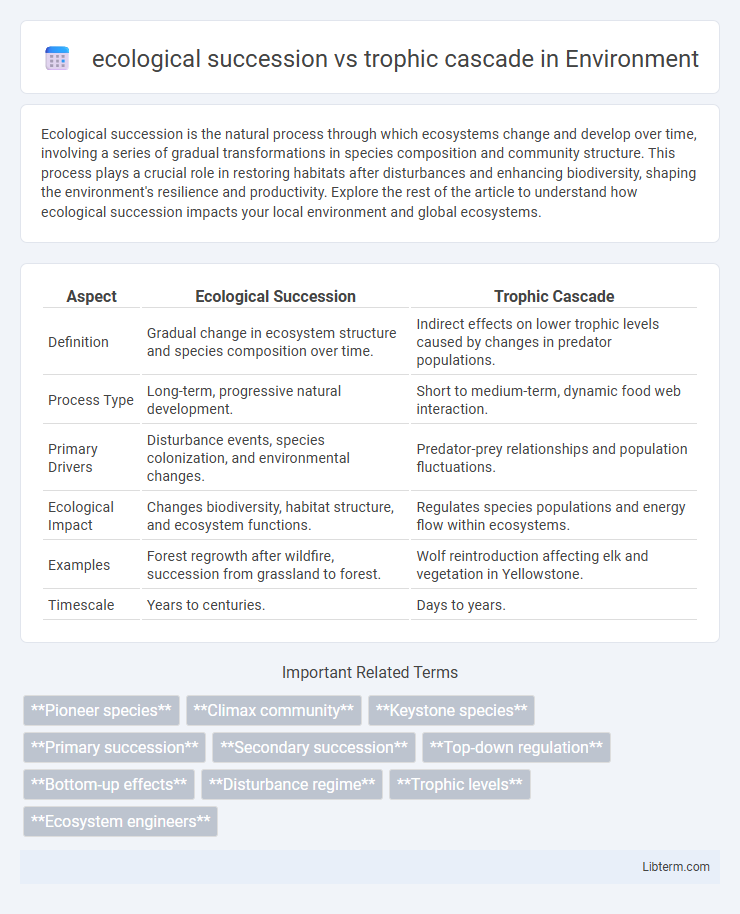Ecological succession is the natural process through which ecosystems change and develop over time, involving a series of gradual transformations in species composition and community structure. This process plays a crucial role in restoring habitats after disturbances and enhancing biodiversity, shaping the environment's resilience and productivity. Explore the rest of the article to understand how ecological succession impacts your local environment and global ecosystems.
Table of Comparison
| Aspect | Ecological Succession | Trophic Cascade |
|---|---|---|
| Definition | Gradual change in ecosystem structure and species composition over time. | Indirect effects on lower trophic levels caused by changes in predator populations. |
| Process Type | Long-term, progressive natural development. | Short to medium-term, dynamic food web interaction. |
| Primary Drivers | Disturbance events, species colonization, and environmental changes. | Predator-prey relationships and population fluctuations. |
| Ecological Impact | Changes biodiversity, habitat structure, and ecosystem functions. | Regulates species populations and energy flow within ecosystems. |
| Examples | Forest regrowth after wildfire, succession from grassland to forest. | Wolf reintroduction affecting elk and vegetation in Yellowstone. |
| Timescale | Years to centuries. | Days to years. |
Introduction to Ecological Succession and Trophic Cascade
Ecological succession describes the natural, progressive changes in species composition and ecosystem structure over time, typically following a disturbance. Trophic cascade involves the top-down effects predators have on lower trophic levels, influencing population dynamics and ecosystem function. Both processes shape biodiversity and ecosystem stability by regulating species interactions and resource availability.
Defining Ecological Succession
Ecological succession describes the natural process through which ecosystems undergo gradual changes in species composition and structure over time, often following a disturbance or the creation of a new habitat. This process can be primary, starting from barren environments like lava flows, or secondary, occurring after events like forest fires or floods, leading to the establishment of mature, stable communities. In contrast, a trophic cascade refers to the top-down effects predators have on lower trophic levels, indirectly influencing ecosystem structure and nutrient cycling rather than long-term species replacement.
Understanding Trophic Cascades
Trophic cascades describe the ripple effects that occur when predators influence the abundance and behavior of prey, impacting multiple levels within an ecosystem's food web. Understanding trophic cascades involves analyzing predator-prey interactions that regulate ecosystem structure, nutrient cycling, and biodiversity. Unlike ecological succession, which focuses on the gradual replacement of species over time, trophic cascades emphasize immediate biotic relationships shaping community dynamics.
Key Differences Between Succession and Cascades
Ecological succession involves gradual changes in species composition and ecosystem structure over time, leading to increased biodiversity and habitat complexity. Trophic cascades occur when changes at one trophic level, such as predator removal or introduction, cause ripple effects that alter population sizes and ecosystem functions across multiple levels. Succession primarily focuses on temporal community development, while cascades emphasize immediate, top-down or bottom-up impacts within food webs.
Stages of Ecological Succession
Ecological succession progresses through distinct stages: primary succession begins on lifeless substrates like bare rock, followed by pioneer species colonization that alters the environment, enabling intermediate species to establish in secondary succession, and culminating in a stable climax community with diverse biodiversity. Trophic cascades occur when top predators regulate populations of herbivores and producers, impacting ecosystem structure, but they do not follow sequential habitat development stages like ecological succession. Understanding successional stages--pioneer, intermediate, and climax--is fundamental for ecosystem restoration and management, whereas trophic cascades emphasize predator-prey dynamics and energy flow.
Mechanisms Driving Trophic Cascades
Trophic cascades are driven by top-down control mechanisms where predators regulate the population of herbivores, indirectly affecting plant communities and ecosystem structure. These cascades often begin with apex predators altering prey behavior or abundance, which subsequently influences lower trophic levels and nutrient cycling. Unlike ecological succession, which is a gradual process of species replacement over time, trophic cascades result from immediate biological interactions within the food web.
Case Studies: Succession in Ecosystems
Ecological succession involves the progressive replacement of species in a habitat over time, as demonstrated in the Glacier Bay, Alaska case where pioneer species initiate soil development enabling later plant communities. In contrast, trophic cascades refer to changes in the population of one trophic level that cascade through lower or higher levels, such as the Yellowstone National Park wolf reintroduction causing ripple effects on elk populations and vegetation. Succession studies highlight long-term ecosystem development processes, while trophic cascade research emphasizes dynamic interactions influencing population and community structure.
Examples of Trophic Cascades in Nature
Trophic cascades occur when predators at the top of the food chain indirectly influence multiple trophic levels below them, such as when sea otters control sea urchin populations, allowing kelp forests to thrive along the Pacific coast. Another classic example is the reintroduction of wolves in Yellowstone National Park, which reduced elk numbers, leading to the recovery of vegetation and stabilization of riverbanks. These cascades demonstrate the powerful regulatory roles predators play in maintaining ecosystem balance through complex food web interactions.
Ecological Impact: Succession vs Trophic Cascade
Ecological succession drives long-term ecosystem development by gradually changing species composition and habitat structure, enhancing biodiversity and ecosystem stability over decades or centuries. Trophic cascades cause rapid shifts in ecosystem dynamics by altering predator-prey relationships, leading to immediate changes in species abundance and nutrient cycling. Succession reshapes ecosystems through progressive biological stages, while trophic cascades trigger abrupt ecological impacts through altered food web interactions.
Implications for Conservation and Ecosystem Management
Ecological succession drives long-term habitat transformation, influencing species composition and ecosystem resilience critical for conservation planning. Trophic cascades, involving predator-prey interactions, regulate population dynamics and nutrient cycling, essential for maintaining ecosystem balance. Integrating both processes aids ecosystem management by promoting biodiversity, enhancing stability, and guiding restoration efforts.
ecological succession Infographic

 libterm.com
libterm.com